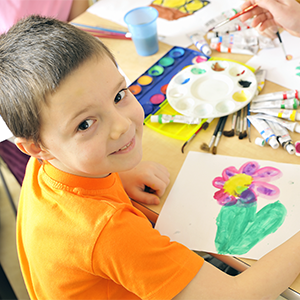Visual and performing arts are a way for children to creatively express
themselves, and can help kids develop an appreciation for the world around
them. Even if you don’t have formal training or special talent, you can
still nurture the arts in your child. Here’s how.
Visual Arts
-
Make supplies accessible.
When your toddler is ready, let him experiment with chunky crayons and
large paper. As he grows, provide a variety of materials that are
accessible any time. Include drawing and painting supplies, as well as
modeling clay, glue, old magazines, wallpaper, fabric scraps and nature
items. Purchase a sketchbook and have him draw one picture a day using
various media and date each page for future reference. -
Go environmental.
Look for art all around you. When you are outside, point out the trees and
the effects the sun has on nature. Comment on the colors of the sunset and
design of the clouds. Visit park statues and city murals. Ask your child if
she wants to draw what she sees. -
Hit the books.
Point out illustrations in children’s books. Talk about colors, shapes and
media used. Who is the illustrator? What do you know about his life? Are
other works of his similar? Find books or other resources that give the
history of famous artists. Learn about how their lives, the period they
lived in and their culture affected their subject and style. Encourage your
child to tell stories with pictures rather than words. -
‘Tis the season.
Take advantage of special times during the year to incorporate art into
your child’s life – create Valentines, dye Easter eggs, carve pumpkins,
decorate birthday cakes. -
Tap into interests.
Use your child’s other interests as springboards for art projects. If he
likes photography, give him a digital camera and have him take pictures. He
could also make a photo collage or draw a depiction of the image he sees in
a photo. -
Offer encouragement.
When commenting on your child’s art, point out the positive features of
each piece and praise the process. Talk about small details to stimulate
conversation about his work such as “I like how you used brown there.” Let
her be carefree and whimsical – blue hair or purple trees show creativity
and individuality. Display items around the house or host a neighborhood
art exhibition to encourage his endeavors. -
Go all out.
Take him to art museums and festivals. Call the museum before you go and
ask if they have children’s activities, printed booklets and/or guides.
When visiting festivals, stop and talk with the artists and learn about
their styles and techniques. -
Enroll in classes.
This exposes your child to a variety of materials and new techniques taught
by trained individuals. It also gives her a chance to work alongside others
her age.
Performing Arts
-
Encourage pretend play.
Have a box of old clothes and accessories on hand so your child can play
dress up. Have him pretend to be an animal or object. How would he move?
What would he sound like? What would his personality be like? Can he make
up a story and act it out? Encourage your child to pantomime rather than
tell stories. Have him create hand puppets and put on a puppet show.As your child gets older, encourage her to write a skit or find a play she
can do with friends or siblings. Or have her put on a musical or dance
performance. Make it into an all-out production by creating tickets,
providing snacks and inviting family and friends. -
Let’s dance.
When he is young, create simple, repeatable dance steps and encourage your
child to engage in rhythmic movement to music. As he gets older, have him
make up his own routines. -
Experiment with music.
Help your child become familiar with differences in pitch and encourage her
to sing songs. Purchase rhythm instruments she can experiment with, or have
her create her own with simple household materials. -
Rely on resources.
Expose your child to music- and story-formatted CDs. Encourage him to sing,
dance or reenact what he hears. Include diverse cultures and genres. Read
books about various professional dancers, musicians and theater performers.
What made them unique? How did the culture and period they lived in
influence their work? -
Expand horizons.
Expose your child to various instruments at your local music store. Let her
try a variety of musical instruments – rent them until she is ready to
commit to playing long term. Enroll in classes or a camp where she can
receive instruction. -
Attend performances.
Go to local dance, music and theater performances. After the production,
discuss the event with your child. What did he like about it? What didn’t
he like? Would he enjoy being part of something like this? If so, find out
more about programs for children his age. -
Record and replay.
Videotape your child while she is dancing, acting or performing music.
Replay it and point out the positive features of what you observe.

